|
Stormhouse
A place for waiting for the end
by Lewis Wadsworth, Assoc. AIA
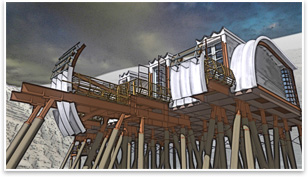 Ed. note: As was the case last year, we were equally moved by Lewis Wadsworth’s word pictures and his drawings. His essay follows below in its entirety. Ed. note: As was the case last year, we were equally moved by Lewis Wadsworth’s word pictures and his drawings. His essay follows below in its entirety.
... the site (this is where to build, this is what can be put here) ... the client (this is what they want, in exactly this shade of this tint of this) ... the crass economics (this is what can be put here ... this is where the not-a-cent-more money can be spent) ... even the vagaries of formal operations (this is the shape ... this is what the style/procedure/computer-program says happens here, as if it matters) ...
Must it always go that way, petty commonplaces driving each project from assigned purpose to imperfect-if-not-botched realization? As if any of those considerations matter ultimately, at the final trumpet-blast, in the end.
That phrase in the end itself can—in fact, does conjure—in fact has conjured up a potential mythology, something with which I might defy the quotidian: this is the house where I wait for the world to come to an end.
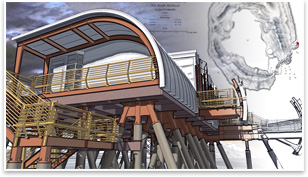 Mythology Mythology
Having latched on to this Mythology as the basis for a work of architecture, in defiance of the usual conventions and rituals I must next determine a site. Where does one go to await such an occasion? Not for me the conventional conventions for "going out with a bang," now that I have a Mythology: no typically grand (or even typically snug) house in a great city, no typically soaring cathedral for my typical prayers, no typically beautiful spot in a beautiful country, not even a typically favorite little resort with a typically special friend for company. I strive to think of some place hard to reach—for I'm not coming back—with little to call me there other than it will be one of the last places to succumb to whatever thing or things (as if it matters) will consume the world.
I think of desperate literary journeys and undertakings. I remember Poe's Pym and his unfinished narrative of an unfinished voyage to the antipodes: South. All the way. Until things start to stop.
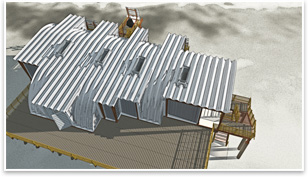 Deception Island Deception Island
The correct site leaps off a map of the Antarctic at me: Deception Island. I like the name. The whole of existence is generally recognized as a deception; so let me witness it being swept away from the vantage of an island named in honor of the great untruth. And the map I have is from 1829, so my site is a deception now too (a volcanic island in a disputed sea is unlikely to remain geographically quiescent for decades, let alone a century and a half). My Deception Island is metaphysical: no oil spills, no noisy tourists looking for penguins and icebergs, no "research" stations waiting for the next eruption or a pointless change of sovereignty. My Deception Island waits alone, bleak and unvisited in a southern sea, for the end of all deceptions.
So: a dark coast, green-less and forbidding, a bleak shore of rock and sand, backed by "ice cliffs" (from the 1829 map), north of a forbidding headland like a giant boulder. This is where (metaphysically, mythologically) I will make the last voyeuristic stand against oblivion in the appropriate architectural vessel and prepare to watch something that might be a storm (but could be any fashionable version of apocalypse, personal or universal) sweep in from the sea (my proxy for the courts of chaos).
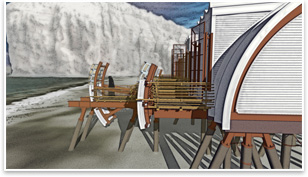 Ship it down, pound it down, lift it up, sheath it up, insulate it in case I have to wait, put on a black cloak—and stand there waiting for the end to come up like the most picturesque of gales. Ship it down, pound it down, lift it up, sheath it up, insulate it in case I have to wait, put on a black cloak—and stand there waiting for the end to come up like the most picturesque of gales.
End from the sea
I imagine the place on pilings to last a bit longer as whatever floods in (ignoring, because this is Mythology, the animosity of wind-driven mini-bergs towards relatively weaker fiberglass-composite poles ... there is probably a way around the issue, and anyway perhaps the bergs will have all melted). The curve of the water-front elevation is a bulwark: metaphysically, spiritually hydrodynamic/aerodynamic. Back of the house is a same-elevated deck for the betarped supplies (or nothing, depending on how long I must linger).
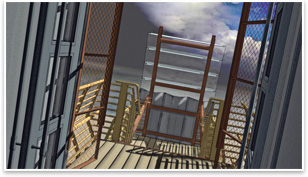 Since the end will come (in my Mythology) from out the sea or over it, I face the openings that face the sea with a shielding grate in front of heavy (insulated and impact-resistant, to be certain) glass set in stout steel doors. Of course, this is primarily a place to watch something or watch for something, so those shielded window-doors must open onto shielded lookout-balconies which take their brunt-shapes from the curving steel arch of the roof (minimum radius of curvature is 10 feet, according to the manufacturer). Re-purposed acrylic arena-spectator shielding will permit view of that ominous horizon. When the waves get too high, I will back into the insulated hull-house proper, shut the grates (I'll have to heroically struggle against the wind, no doubt, to get it done), push the doors closed until the gaskets engage, and watch the last act through the glass. Since the end will come (in my Mythology) from out the sea or over it, I face the openings that face the sea with a shielding grate in front of heavy (insulated and impact-resistant, to be certain) glass set in stout steel doors. Of course, this is primarily a place to watch something or watch for something, so those shielded window-doors must open onto shielded lookout-balconies which take their brunt-shapes from the curving steel arch of the roof (minimum radius of curvature is 10 feet, according to the manufacturer). Re-purposed acrylic arena-spectator shielding will permit view of that ominous horizon. When the waves get too high, I will back into the insulated hull-house proper, shut the grates (I'll have to heroically struggle against the wind, no doubt, to get it done), push the doors closed until the gaskets engage, and watch the last act through the glass.
I probably wasn't as careful as I should have been with the flashing details, given the amount of whatever (waves, rain, tears?) dashing against the front, and the salt will eventually eat into the galvalume. But then this doesn't have to last forever:
My Stormhouse. |



